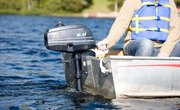Out on the water is the last place you need to be when your motor acts up. One problem that can strand you on your favorite lake is low fuel pressure. Fuel starvation problems lead to poor performance, or even no performance with any motor. Low fuel pressure may be from vapor lock, which usually happens in the summer; vacuum lock, which can happen any time; or restrictions in the fuel system. One clear symptom is that the motor runs fine until you push the throttle forward, at which point the motor seems to sputter or it even dies.
Items you will need
Low-pressure fuel filter
Fuel lines
Fuel connectors
Portable fuel tank
Fuel
Small piece of wire (optional)
Replace the low-pressure fuel filter. A blocked low-pressure fuel filter causes hard starting, stalling, misfire or poor performance. This is the most likely cause when the engine's problem worsens with the increased engine speed of acceleration.
Pressurize the fuel system with the priming bulb. Check all fuel system fittings and hoses for leaks that might cause a drop in fuel pressure. Replace connectors and hoses that are leaking or questionable.
Run the motor on a test tank of fuel. Fill a portable tank with fresh gasoline and connect it to the motor. Run the motor through its full range of speed. If the motor runs fine on the test tank, open the top of your boat's fuel tank and pressurize the fuel system. Start the motor. If the problem abates, clear your fuel tank vent with a small piece of wire or replace the tank altogether. If it doesn't, replace the fuel in the tank.
Tips
- Use a test tank with fuel lines at least as large as those on your boat. Otherwise you could cause fuel starvation problems or other symptoms that will make troubleshooting nearly impossible.
References
- "Yamaha/Mercury/Mariner Outboard Repair Manual 2 - 250 HP 1995-2004"; Seloc Marine; 2007
Tips
- Use a test tank with fuel lines at least as large as those on your boat. Otherwise you could cause fuel starvation problems or other symptoms that will make troubleshooting nearly impossible.
Writer Bio
Will Charpentier is a writer who specializes in boating and maritime subjects. A retired ship captain, Charpentier holds a doctorate in applied ocean science and engineering. He is also a certified marine technician and the author of a popular text on writing local history.



